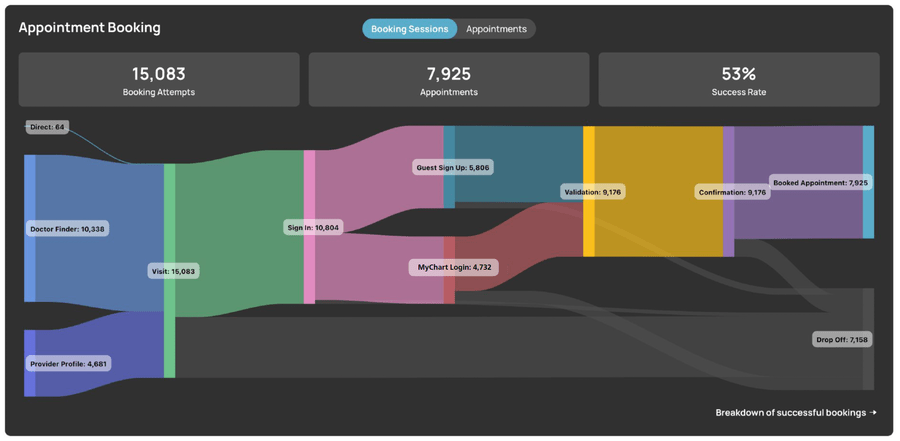2 easy things healthcare marketers can do to start 2024 with a bang
2023 was a tough year for healthcare marketers. Budgets were cut, priorities slid in a dozen different directions at once, and tools we’ve used for decades became poisoned chalices locked behind glass by our Security and Compliance teams.
2024 looks like it is going to be a year of recovery: healthier margins, more favorable patient mix, and higher volumes.
Thinking you might be bored? Don’t worry – there will be exciting new challenges and being able to ‘prove it’ is going to be even more important. Marketers that can get it right will have real ways to show their contribution to the organization’s bottom line and will see their budgets grow.
Don’t get overwhelmed by trying to fix everything all at once. Every journey begins with a single step so here are two bite-sized things you can do today to set yourself up for success in the year ahead:
Connect your marketing campaigns to your online appointment scheduling
When your CFO is looking at operational budget requests (your marketing budget falls into that category) they’re typically evaluating them through an ROI lens: will spending this money result in our hospital making more money. You’ve got a much better chance of having your requests approved if you can say “yes!” with confidence.
Your CFO wants to understand how marketing spend results in conversion.
Getting realtime reimbursement or margin back from your EMR or financial systems can be a long journey that requires the blessing of lots of IT and operational committees. Those looking for an easier path to similarly ROI-focused metrics might want to try feeding awareness of marketing campaign referral sources directly into your appointment scheduling tools.
Your marketing platform (or digital marketing agency) should be able to deliver a unique identifier for every campaign segment or referral source. This is typically fed into your analytics platform (your newly HIPAA compliant analytics platform…) to understand engagement and conversion.
You just need to take it one step further!
In your appointment scheduling platform there is likely a field for referral source attached to individual appointment records. Talk to your platform vendor or internal technical resources about populating that field with the marketing referral source identifier. The parameter can typically be passed in the URL or as a session variable. The identifier is generic, even when attached to a patient’s session, and so still complies with HIPAA regulations.
Your campaign effectiveness reporting gets a lot more interesting when you can speak directly to how many actual appointments were generated by which campaign segment. Jazz it up even more by segmenting by which appointment type each campaign drove.
Improve the usability of your doctor finder and appointment booking workflow
Now that you’re attaching campaign segments (and corresponding marketing spend) to actual appointments, you can start to understand how much each of those appointments costs to generate.
Which is great news!
But, as Spiderman learned the hard way, with great power comes great responsibility.
Knowing your marketing cost per appointment (CPA or cost per acquisition or cost per conversion) means that you are now responsible for lowering it.
There are a lot of different factors that contribute to that CPA: keyword competition, medical specialty, patient demographics, and market demand. There’s one critical factor that you can address directly as a healthcare marketer: doctor finder and appointment scheduling usability.
Through the millions of appointments booked through our platform, Sparkle, we have seen how incremental improvement in user experience results in outsized gains in conversion metrics. Gains that translate directly to a dramatically lower cost per acquisition.
The majority of your site visitors are new to healthcare and searching for and selecting a doctor can be a confusing task. Wading through healthcare-specific language and unfamiliar insurance requirements to book an appointment can be even more difficult. Put in extra effort to make the whole process as straightforward and user friendly as possible and you’ll be rewarded with not just higher patient volume but also happier, more loyal patients.
Look to your doctor finder and appointment scheduling platform’s reporting tools to understand where people are getting stuck.
Sparkle’s first-party, HIPAA-compliant reporting makes great use of visualization tools like Sankey charts that break the acquisition pipeline down, showing you exactly where people are dropping off. Use charts like this to understand what parts of your pipeline need some extra attention:

In our experience, the next step is to put your I’m-pretending-I’m-a-patient hat on to walk through the search and booking experience yourself. If you find yourself getting frustrated, there’s a good chance you’ve uncovered something that needs repair.
Your doctor finder and appointment scheduling platform should be doing as much of the thinking for the patient as possible. If they’re searching for a layperson term related to a condition, does your doctor finder return the most relevant physicians? If you’re an existing patient scheduling an appointment as a guest, is your platform smart enough to validate that appointment against EMR decision trees?
Once you start to look more deeply, you’ll be surprised how much delicious low-hanging fruit there is to gobble up.
2024 is brand new and full of potential. We’d love to show you how Sparkle can help you to turbocharge your marketing efforts, demonstrate success, and give your patients the best possible digital experience.